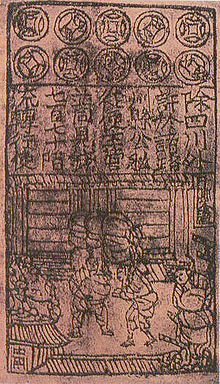
| Part of a series on the |
| History of science and technology in China |
|---|
 |
The Song dynasty (Chinese: 宋朝; 960–1279 CE) witnessed many substantial scientific and technological advances in Chinese history. Some of these advances and innovations were the products of talented statesmen and scholar-officials drafted by the government through imperial examinations. Shen Kuo (1031–1095), author of the Dream Pool Essays, is a prime example, an inventor and pioneering figure who introduced many new advances in Chinese astronomy and mathematics, establishing the concept of true north in the first known experiments with the magnetic compass. However, commoner craftsmen such as Bi Sheng (972–1051), the inventor of movable type printing (in a form predating the printing press of Johannes Gutenberg), were also heavily involved in technical innovations.
The ingenuity of advanced mechanical engineering had a long tradition in China. The Song engineer Su Song, who constructed a hydraulically-powered astronomical clocktower, admitted that he and his contemporaries were building upon the achievements of the ancients such as Zhang Heng (78–139), an astronomer, inventor, and early master of mechanical gears whose armillary sphere was automatically rotated by a waterwheel and clepsydra timer.[1] The application of movable type printing advanced the already widespread use of woodblock printing to educate and amuse Confucian students and the masses. The application of new weapons employing the use of gunpowder enabled the Song to ward off its militant enemies—the Liao, Western Xia, and Jin with weapons such as cannons—until its collapse to the Mongol forces of Kublai Khan in the late 13th century.
Notable advances in civil engineering, nautics, and metallurgy were made in Song China, as well as the introduction of the windmill to China during the thirteenth century. These advances, along with the introduction of paper-printed money, helped revolutionize and sustain the economy of the Song dynasty. Song era antiquarians such as Ouyang Xiu (1007–1072) and Shen Kuo dabbled in the nascent field of archaeology and epigraphy, inspecting ancient bronzewares and inscriptions to understand the past. Advances were also made in the field of forensics, in particular by Song Ci (1186–1249), author of the Collected Cases of Injustice Rectified that covered topics such as autopsies in murder cases and first aid for victims.
- ^ Needham, Volume 4, Part 2, 466.